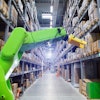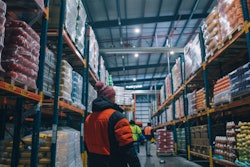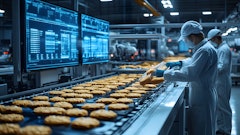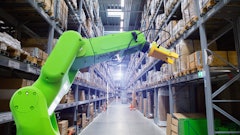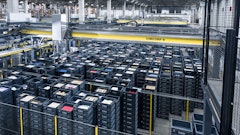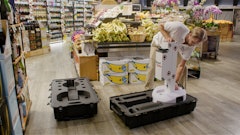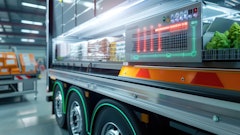
Amazon’s recent announcement that they are nearing more robots than human workers in their warehouses has resurfaced the discussion around the role robotics play within the human workforce. It’s a valid conversation, but hopefully with a positive outcome.
Despite fears that robots are taking over, the human workforce is not going anywhere. Instead, robotics will and already enhance workforces through smarter deployment of people and technology, addressing critical labor shortages while creating pathways to higher-skilled, more valuable roles.
Empty shifts, full demand
Nearly half of supply chain decision makers report labor shortages as a primary challenge in their warehouses. With consumer expectations at an all-time high and e-commerce rates steadily increasing year over year, its critical warehouses can fill the gap.
An easy solution is hiring younger, new-to-the-workforce employees to quickly bridge the gap, however, a growing disinterest in blue-collar jobs amongst Gen Z has led to more unfilled positions and oftentimes more turnover in the positions that are filled. For 65% of workers aged 18–29, labor-related roles serve as short-term solutions rather than career paths, as 51% leave these roles within six months. Traditional warehouse work, perceived as physically demanding with little to no advancement opportunities, doesn’t align with this generation's expectations for growth, financial security, and flexibility.
The impact of the labor shortage and the challenges addressing it is substantial. Over 40% of warehouse operators report forgoing revenue due to insufficient staff for inventory management, while fulfillment times are increasing by 60%. On the frontend, customer service is impacted by resource constraints creating operational bottlenecks that ripple throughout entire supply chains.
Something must change.
Robots lift heavy, humans lift higher
Rather than displacing workers, warehouse robotics are fundamentally redefining human roles by automating demanding, high-risk tasks while attracting new employees with higher-value roles.
The fact is, there are simply some tasks better suited for robots than humans. Modern warehouse robotics excel at tasks that require precision, endurance, and consistency such as lifting heavy items, navigating predetermined paths, and performing repetitive motions. While the robots handle the grunt work, warehouse operators are freed up for complex problem-solving, exception management, and tasks requiring dexterity and judgment. When systems encounter real-world problems, such as weather delays or equipment malfunctions, humans step in to recover and adapt, creating true collaboration between automation and human intelligence.
This technological evolution creates entirely new job categories with significantly higher compensation. Currently, the highest paying salary for warehouse workers caps out at $80,000, however, automation and robotics technicians have room for more growth, especially with upskilling. Unlike traditional warehouse roles, these positions enable workers to feel fulfilled by providing access to specialized fields with higher pay, better job security, and opportunities for advancement.
While the use of warehouse robotics supplements the labor gap, it also introduces emerging roles, including technicians who maintain and troubleshoot automated systems, requiring knowledge of electronics, mechanics, and computer programming. Data analysts optimize warehouse operations through sensor-generated insights, while quality control specialists address exceptions and resolve complex problems. These positions combine skills in engineering, computer science, and AI, enabling workers to interact with cutting-edge technologies such as machine learning and automation.
The delineation of work between humans and warehouse robotics represents a critical lesson: robots are not replacing human jobs, they are simply elevating the human workforce into more fulfilling roles. In fact, 65% of warehouse companies have implemented reskilling programs over the last year, and 42% of managers believe these programs reduce turnover. In materials handling specifically, 87% of companies reported that upskilling boosted operational efficiency and 60% reported reduced turnover following training programs, demonstrating how automation creates pathways for career advancement rather than job elimination.
The automation playbook
Achieving the benefits of warehouse robotics and an upskilled workforce is no small task; it requires thoughtful planning and execution. Companies who rush into automation without proper preparation often face resistance, cost overruns, and operational disruptions.
The most successful implementations of automation are slow and steady, allowing human workers the time to learn how to work with the equipment. Especially during early deployments, this means maintaining a high level of human oversight while workers adapt to new technologies and leadership can identify opportunities for optimization. Gradually, the need for intensive human oversight alleviates, and your workforce is in the perfect position for upskilling into new roles.
Implementing employee upskill programs is not just a benefit to warehouse processes overall – it’s necessary for retention. For many older workers, seeing these new, high-tech machines enter a facility they’ve always known as manual can be daunting for fear of being replaced. But, they have the needed know-how and experience to complement elevated work. Upskill programs enable workers to develop and enhance the technical skills necessary for operating and maintaining robotic systems, as well as analytical skills for interpreting data and optimizing processes.
Alongside upskilling, organizations must clearly communicate how robotics enhance rather than replace human roles to help build buy-in. Successful companies involve employees in the implementation process, seeking their input on workflow optimization and system design. This ensures employees embrace the transition and their new positions in the organization.
Looking toward the future
As companies continue to grapple with workforce challenges, those embracing human-robot collaboration will build more resilient and attractive workplaces. The transformation of warehouse labor through robotics automation represents a fundamental shift from viewing technology as job displacement to recognizing it as workforce enhancement.
The future belongs to organizations who recognize robotics not as a replacement for human workers, but as a powerful tool for elevating human potential and creating sustainable competitive advantages.



